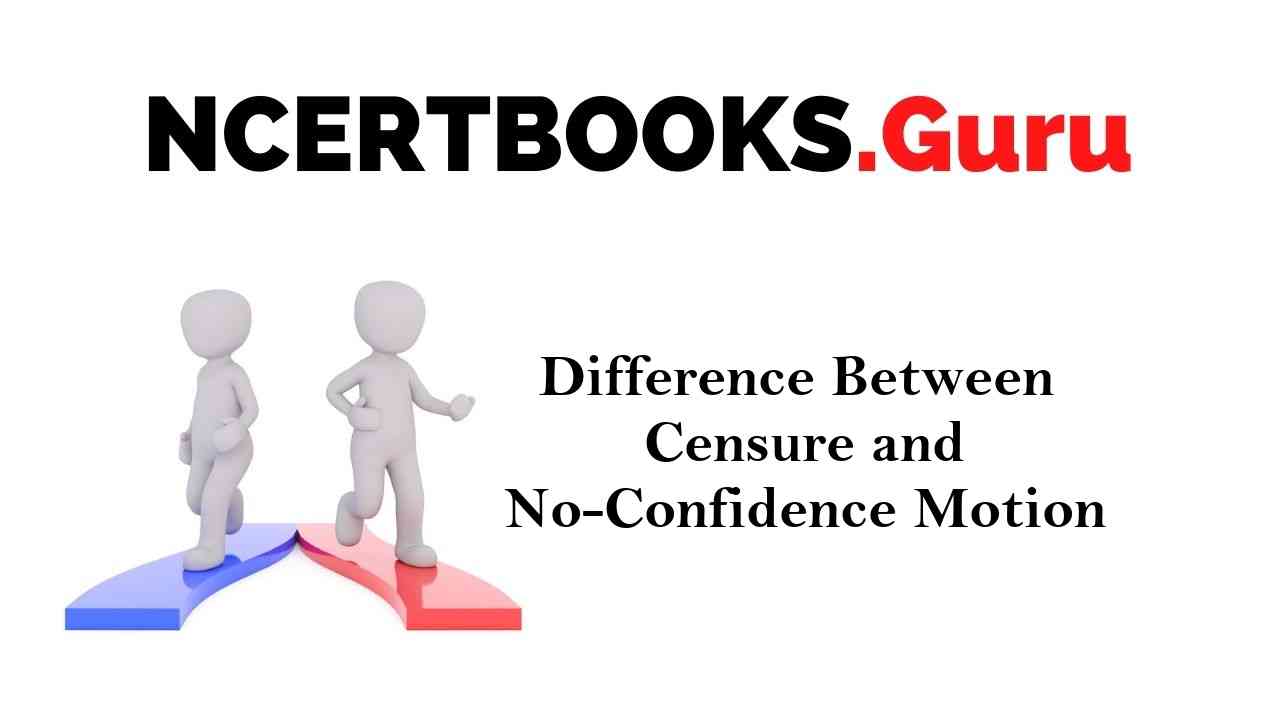In the Legislative procedure, Censure is a questionable critical resolution that should be approved with a plurality vote in. The types it can take include an extreme reprimand by a legislature, a biblical punishment levied by a church, or a critical decision based on a religious argument. Censure’s motion is a central motion voicing a deep disagreement that the assembly must discuss and vote by plurality.
You can also find differences between articles on various topics that you need to know. Just tap on the quick link available and get to know the basic differences between them.
What is the major Difference Between Censure and No-Confidence Motion
The motion of no confidence is a declaration or vote whether a person in a duty role (government, managers, etc.) is no longer fit to hold that position, either because of any manner they are inadequate, because of their incompetence, because of their failure to perform their responsibilities or because they take actions that other members find adverse.
It shows the Head of State, as a legislative resolution, that the elected parliament no longer has confidence in the designated government (one or more). In some nations, they have to resign along with the Council of Ministers when a vote of no confidence is voted against a single minister.
| Subject | Censure | No-Confidence Motion |
| Specification | The first and foremost difference between the Censure and No-confidence motion is that It is mandatory to provide the reasons for introducing a censure motion in the Lok Sabha. | In contrast, in the case of a No-confidence motion, there is no such compulsion required to provide the reasons in the Lok Sabha. |
| Applicability | An individual Minister or a group of ministers or the whole Council of Ministers can vote against the Censure Motion. | Only the entire Ministerial Council can accept a vote of no confidence. |
| Enactment | A Censure is passed to censure on particular measures and motions of the Council of Minister. | The motion of confidence is moved to create the Lok Sabha’s confidence in the Ministerial Council. |
| Restrictions | In the case of Censure, if the resolution is accepted in the Senate, there is no need to resign for anyone in the council of ministers. | In contrast, in the case of the No-Confidence Motion, the whole ministry, including the prime minister, has to withdraw from office in the Lok Sabha if it is passed. |
| Threat in System | A motion of confidence in a legislative system is a declaration or a decision that a state is no longer considered fit for remaining in the office. | Still, the Censure motion carries no such threat of not being deemed appropriate in the system. |
| Movement | A motion of no confidence can only be pushed in Lok Sabha. Rajya Sabha (or state legislative council) is not permitted to move the Motion of Confidence. | Simultaneously, the Censure can be passed both in the State Assembly (Lok Sabha) and the State Legislative Council (Rajya Sabha). |
Specification
The first and foremost difference between the Censure and No-confidence motion is that It is mandatory to provide the reasons for introducing a censure motion in the Lok Sabha. In contrast, in the case of a No-confidence motion, there is no such compulsion required to provide the reasons in the Lok Sabha.
Applicability
Secondly, an individual Minister or a group of ministers or the whole Council of Ministers can vote against the Censure Motion. On the other hand, Only the entire Ministerial Council can accept a vote of no confidence.
Enactment
A Censure is passed to censure on particular measures and motions of the Council of Minister. In other words, the motion of Censure is shifted to obtain the government of power’s rejection of such policies. It aims at criticizing the government’s defeats.
The motion must specifically show the allegations against the government. As soon as the Censure Motion is passed, the government shall obtain the trust of the house. On the other hand, the motion of confidence is moved to create the Lok Sabha’s confidence in the Ministerial Council.
Restrictions
In the case of Censure, if the resolution is accepted in the Senate, there is no need to resign for anyone in the council of ministers. In contrast, in the case of the No-Confidence motion, The whole ministry, including the prime minister, has to withdraw from office in the Lok Sabha if it is passed.
Threat in System
A motion of confidence in a legislative system is a declaration or a decision that a state is no longer considered fit for remaining in the office. Still, the Censure motion carries no such threat of not being deemed appropriate in the system.
Movement
According to procedures (or state assembly as the case may be), a motion of no confidence can only be pushed in Lok Sabha. Rajya Sabha (or state legislative council) is not permitted to move the Motion of Confidence. Simultaneously, the Censure can be passed both in the State Assembly (Lok Sabha) and the State Legislative Council (Rajya Sabha).
Actions to be Censured
Actions of individual members can only be censured in the case of Censure Motion. On the other hand, Article 75 of India’s Constitution states that As soon as the Lok Sabha is enjoyed by a majority of the members of the assembly, the council of ministers shall jointly be accountable.
Conclusion
Therefore, if Censure’s motion against a government is passed, the Council of Ministers shall pass a motion of confidence to restore the hours of confidence as soon as possible. The number of censure motions that can be brought during a sitting is not reduced.
Still, the no-trust motion here is exclusively to ensure that Lok Sabha trusts the Council of Ministers instead of a censure motion, where critics/disapproval are also the objects of this motion.
